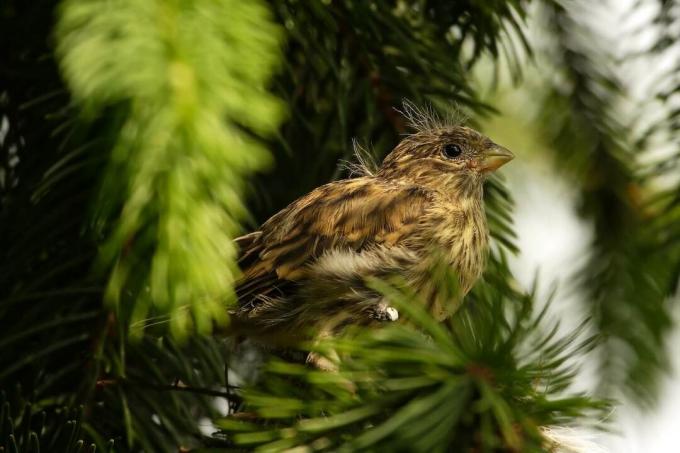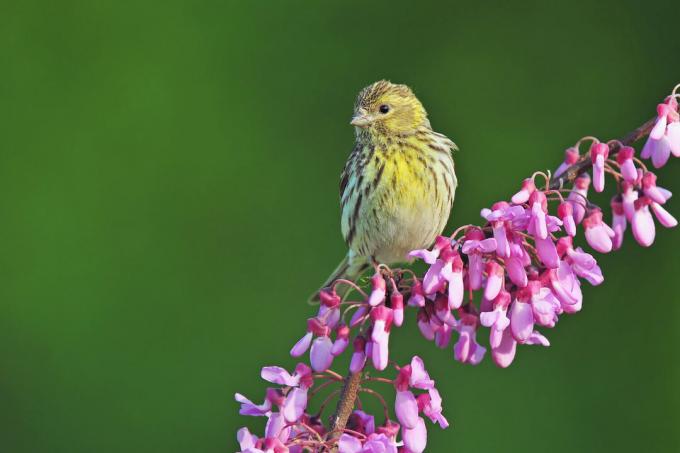What do girlitzes look like? Where does it live and what does the bird eat? We have all the important information and pictures about this special finch.

The Girlitz (Serinus serinus) is our smallest domestic finch. However, this is by no means inconspicuous. With its lemon-yellow plumage and high, clinking singing, the girlitz is actually a small splendid specimen among songbirds. It has been known for these properties since ancient times and has always been kept in aristocratic circles as a cage bird. He was only replaced in the 15th Century, when the Canary-Girlitz (Serinus canaria) was brought from the Canary Islands to the mainland. From this the diverse canaries were later bred. Nevertheless, the girlitz is still kept as a cage bird today, even if bird trapping is of course strictly forbidden in Germany. You can find more exciting facts and pictures in our profile below.
contents
- Girlitz: A detailed profile
-
This is how you recognize the girlitz
- How does girlitz singing sound?
- How do you recognize the young girlitz birds?
- How do you recognize the eggs of the girlitzes?
- What is the difference between girls and girls?
- Which habitat does the Girlitz prefer?
- Where does he build his nest?
- When does the girlitz breed?
- Where does the little finch spend the winter?
-
Support the Girlitz: That's how it works
- What does the girl eat?
- Which nesting aids are suitable for the yellow finch?
- How can one additionally support the Girlitz?
Girlitz: A detailed profile
| size | About 11-12 cm |
| weight | About 11-13 g |
| Breeding season | April June |
| lifespan | About 5 years |
| habitat | Parks and gardens |
| food | Fine seeds, leaf and flower buds |
| Threats | Lack of habitat, bird trapping for sales purposes |
This is how you recognize the girlitz
The Girlitz can be recognized by its piercing song as well as its colorful plumage. The bird is characterized by its small size and tiny, triangular finch bill. The back and elytra are strongly striped gray-yellow. The gray cheeks are framed by bright yellow lines and the head is crowned by a yellow forehead. The yellow color continues over the chest and stomach and ends in white flanks. In flight, the girlitz can also be recognized by its lemon-yellow lower back - also known as the rump.
The Girlitz is actually only confused with the in the field Goldhammer. However, this is significantly larger and is characterized in its splendid dress by an almost completely yellow head and a red-brown chest.

How does girlitz singing sound?
The girlitz has a very special and easily recognizable bird's voice. His singing is high, wild and clanky and consists of an unstructured, fast and coherent stanza. The voice is somewhat reminiscent of the squeaking of unlubricated gears.
This is how the girl's song sounds:
How do you recognize the young girlitz birds?
The young girlitzes are a little better camouflaged than their parents and therefore more difficult to recognize. They still lack the bright yellow color that characterizes this species. The plumage of the young birds is from a beige to dirty-white basic color and streaked with strong, gray-brown stripes.
How do you recognize the eggs of the girlitzes?
The Girlitz female lays three to five eggs per season in a bowl-shaped nest made of grass, leaves, moss and other fine plant parts. The inside of the nest is carefully padded with lots of feathers and animal hair. The eggs themselves are between 15 and 18 millimeters in size, have a pale blue or green base color and are covered with brownish-red spots.
What is the difference between girls and girls?
As is so often the case in nature, the male girls are a bit more conspicuous than their female partners. While the male is adorned with sulfur-yellow elements, the female has somewhat more matt, greenish-yellow patterns. Her chest is also criss-crossed with dark lines, while her partner presents a pure, bright yellow chest.

Which habitat does the Girlitz prefer?
Girlitzes love semi-open landscapes with scattered trees and high bushes, which they can use as hiding places and nesting places as well as singing stations. They mainly look for their food on the ground. Wild meadows with wild herbs bearing seeds are particularly popular. But the girlitz has also adapted to urban landscapes and is therefore not infrequently found in parks, gardens or on the outskirts of cities.
Where does he build his nest?
The girlitz only builds its nest after a careful selection of the breeding site. This should be as well hidden as possible in a dense, high bush or tree, but at the same time a good one A view and a singing point offer, from which the male characterizes his territory with impressive singing interludes can. The female herself builds the nest.
When does the girlitz breed?
The breeding season of the girlitze extends from April to June. During this time, males and females remain strictly loyal to each other and can raise up to two broods. After laying eggs, Ms. Girlitz incubates her eggs for about two weeks while the male guards and defends them and the common nest. After hatching, the young birds are fed by both parents with a mixture of pre-soaked, fine seeds and protein-rich small insects such as aphids and caterpillars. After 16 to 17 days, the young are so developed that they can leave the nest on their own and explore the area. They are then supported by their parents for a few days in their search for food before they devote themselves to a possible second brood. Then the little ones are on their own.

Where does the little finch spend the winter?
The majority of our German girlitzes escape their uncomfortable breeding areas in the cold winter months and go to the western Mediterranean area. However, since they do not have to travel too long distances, the last birds do not move to their winter quarters until November and are already back with us from March.
Support the Girlitz: That's how it works
If you want to set up a small living space for the Girlitz in your own home, you must first understand the requirements the little bird places on a home. In the following sections you will learn how you can support the girlitz in foraging for food, in building nests and even in body care.

What does the girl eat?
Giritzes feed mainly on fine seeds. These can come from a variety of wild herbs, which you can find in our special article on the subject of "Herbs for birds“Get to know. However, they also use flower and leaf buds in spring and smaller insects to raise their young. If you would like to offer the finches additional food, you should stick to the natural diet as much as possible. A grain feed with sunflower seeds and finer wild herb seeds is well suited. Note, however, that most of the native girlitzes spend the winter further south and are therefore rarely seen at snow-covered bird feeders.
With our Plantura all year round feed however, you can also support the garden birds in summer and during the breeding season. The protein-rich feed with extra feed lime is ideal for prospective bird parents.
Which nesting aids are suitable for the yellow finch?
As a free-breeding bird, the girlitz cannot be impressed with a classic nesting box. Such structures are more like for cave breeders Blue tits or Starlings suitable. Instead, the little finch appreciates more natural breeding opportunities. In your garden, make sure not to thin out the hedges and tree tops too much, in order to provide the girlitz with good hiding places for its nest.
How can one additionally support the Girlitz?
Especially in the breeding season and for the rearing of the young birds, the Serin depends not only on seeds but also on protein-rich insects. Like many other songbirds, the yellow finch therefore suffers from persistent insect decline. Our can help Plantura beneficial insect magnetwith the help of which you can create an insect paradise in your own garden. With it you can not only make the girlitz happy, but also bring a lot of useful pollinators and pest killers into your garden.
Bathing is also a favorite pastime of the Girlitzes on hot days. The birds can often be seen grooming themselves in small puddles. A bird bath can also be easily made from a flat bowl or a large trivet, which conveniently also functions as a drinking trough.
But be careful: let a bird bath or drinking trough dry out completely on a regular basis or change the water and clean the bowl. This is because such meeting places for birds can quickly become contaminated and lead to the transmission of infectious diseases. The risk of infection increases especially at high temperatures, which is why it is best to clean a bird bath every day on hot days.

All garden birds appreciate a little help in their daily struggle for food and other resources. If you want to find out more about our feathered friends, take a look at our other species portraits and learn about them, for example Barn Swallow know something better.
